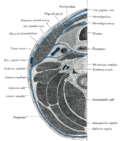| Anterior jugular vein | |
|---|---|
 The veins of the neck, viewed from in front (anterior jugular visible at center) | |
 Veins of the head and neck (anterior jugular visible at bottom right) | |
| Details | |
| Drains to | External jugular vein |
| Identifiers | |
| Latin | vena jugularis anterior [1] |
| TA98 | A12.3.05.047 |
| TA2 | 4959 |
| FMA | 13318 |
| Anatomical terminology | |

